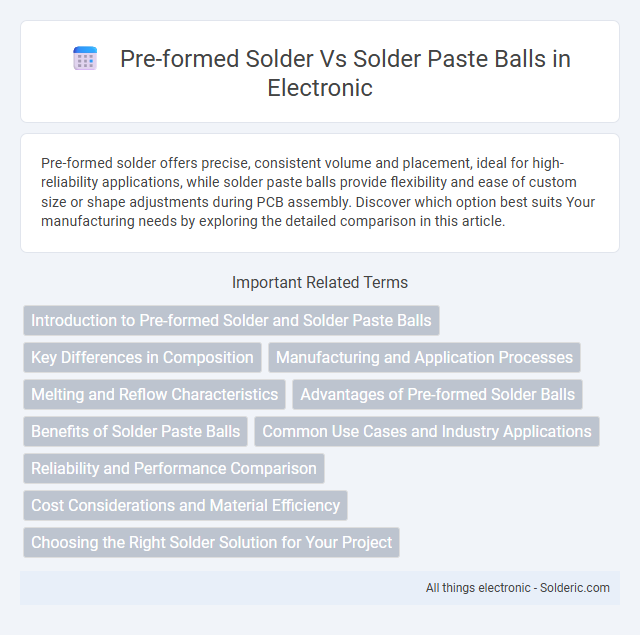Pre-formed solder offers precise, consistent volume and placement, ideal for high-reliability applications, while solder paste balls provide flexibility and ease of custom size or shape adjustments during PCB assembly. Discover which option best suits Your manufacturing needs by exploring the detailed comparison in this article.
Comparison Table
| Feature | Pre-formed Solder | Solder Paste Balls |
|---|---|---|
| Form | Uniform, solid solder spheres | Compressed solder powder in ball shape |
| Application | Wave, reflow, and selective soldering | Primarily reflow soldering |
| Consistency | Precise, consistent volume and weight | Variable, depends on powder distribution |
| Storage | Stable, long shelf life | Sensitive to humidity and storage conditions |
| Usage | Direct placement on pads or leads | Requires stencil printing and reflow |
| Cost | Higher material cost due to precision manufacturing | Lower cost, easier mass production |
| Reliability | High joint reliability and uniformity | Potential for voids and inconsistent joints |
| Ideal Use | High-reliability electronics, fine-pitch components | General electronics assembly, cost-sensitive projects |
Introduction to Pre-formed Solder and Solder Paste Balls
Pre-formed solder offers precise, uniform shapes designed for consistent solder joints, enhancing reliability in electronic assembly. Solder paste balls consist of tiny spheres of solder alloy mixed with flux, enabling efficient reflow soldering in surface mount technology. Understanding the differences helps you choose the right method for optimized thermal performance and assembly quality.
Key Differences in Composition
Pre-formed solder consists of uniform, shaped solder pellets typically made from tin-lead, tin-silver-copper, or other alloy compositions, ensuring consistent alloy ratios and minimal oxidation. Solder paste balls are composed of micron-sized solder powder mixed with flux, creating a viscous material with variable metal content and flux activators essential for promoting wetting during reflow. The key difference lies in the physical state and flux integration, with pre-formed solder being solid metal and solder paste being a semi-liquid suspension designed for precise printing and melting.
Manufacturing and Application Processes
Pre-formed solder offers precise volume control and consistent shape, enabling reliable placement during automated assembly, while solder paste balls provide flexibility in adjusting solder volume through dispensing techniques. In manufacturing, pre-formed solder requires specialized equipment for accurate pick-and-place operations, whereas solder paste balls are compatible with stencil printing and reflow soldering processes. Application-wise, pre-formed solder suits high-volume, fine-pitch assemblies with minimal solder joint variability, whereas solder paste balls are favored for prototype and small-batch productions due to easier customization and cost-effectiveness.
Melting and Reflow Characteristics
Pre-formed solder offers precise volume and shape control with consistent melting points allowing predictable reflow profiles, essential for high-accuracy applications. Solder paste balls contain flux and metal particles creating a homogeneous mixture that melts uniformly but may introduce variability in volume and shape during reflow due to flux outgassing. Understanding the distinct melting behaviors and thermal profiles helps optimize solder joint reliability and manufacturability in surface mount technology.
Advantages of Pre-formed Solder Balls
Pre-formed solder balls offer precise volume control and consistent shape, ensuring uniform solder joints on PCB assemblies. Their ability to minimize solder paste printing defects improves overall assembly reliability and reduces rework costs. By using pre-formed solder balls, you achieve better placement accuracy and enhanced joint strength compared to traditional solder paste balls.
Benefits of Solder Paste Balls
Solder paste balls offer precise volume control and uniformity, ensuring consistent solder joints in surface mount technology (SMT) applications. Their ability to reduce bridging and improve wetting enhances overall reliability and reduces rework costs. When you choose solder paste balls, you benefit from faster assembly times and better alignment with automated pick-and-place machines.
Common Use Cases and Industry Applications
Pre-formed solder offers precise volume control and is widely used in automated assembly for high-reliability applications such as aerospace and medical devices. Solder paste balls excel in reflow soldering for fine-pitch components, making them ideal for consumer electronics and automotive circuit boards. Your choice between these materials depends on factors like production volume, component complexity, and the required mechanical strength.
Reliability and Performance Comparison
Pre-formed solder offers superior consistency in joint quality due to its precise volume control, reducing defects and enhancing reliability in high-performance electronic assemblies. Solder paste balls, while providing flexibility in automated processes, can exhibit variations in volume and solderability that may affect joint integrity and long-term performance. Reliability testing commonly shows pre-formed solder achieving higher repeatability and better mechanical strength, making it preferable for critical applications requiring robust thermal and electrical connections.
Cost Considerations and Material Efficiency
Pre-formed solder offers precise volume control, reducing material waste and potentially lowering overall costs in large production runs. In contrast, solder paste balls can lead to inconsistent material usage and more frequent rework, increasing cost inefficiencies. You can optimize your budget by selecting pre-formed solder for applications requiring material efficiency and consistent weight.
Choosing the Right Solder Solution for Your Project
Pre-formed solder offers precise control over solder volume and shape, making it ideal for high-reliability applications requiring consistent joints. Solder paste balls provide flexibility and ease of application in automated processes, especially suitable for fine-pitch components and complex PCB layouts. Your choice depends on factors like assembly accuracy, equipment availability, and project scale to ensure optimal solder joint quality and performance.
Pre-formed solder vs solder paste balls Infographic

 solderic.com
solderic.com